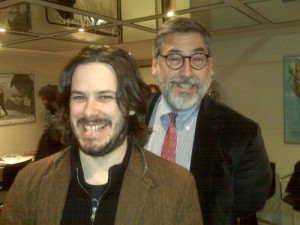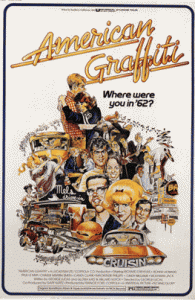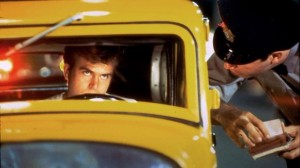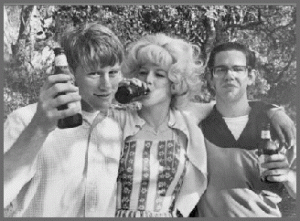When you’re surrounded by bounties, it’s hard not to become inured, and/or spoiled. Such is the case for repertory fans in Los Angeles. It seems at least twice a year someone shows Lawrence of Arabia in 70mm, and that’s just for starters. Between Cinefamily, The Egyptian and the Aero and – of course – the much beloved New Beverly, there is a constant stream of old movies, often with celebrity guests both attending and talking about the films in question. Some of whom – quite painfully – have nothing to say. As such, it makes it sometimes harder to get excited about seeing films that you may have seen dozens of times. To quote Ride with the Devil “It ain’t right and it ain’t wrong, it just is.”
 Enter Edgar Wright. For his second run programming the New Beverly, he brought out a number of classics, and a number of under-seen gems that are great to see on the big screen. Wright has said repeatedly that his programming was meant for one person: himself. He just wanted the chance to see all of these films on the big screen. I have been attending as much as possible. God, it’s always a pleasure. Last night I got to see The Driver and Duel on the big screen. I also got a chance to shake Walter Hill’s hand. My god, the legend. And after running into a publicist, he introduced me to Brie Larson (Envy Adams in Scott Pilgrim, and star of my favorite set piece from 2010), and we geeked out on how great The Driver was. She brought up Le Samourai, and I mentioned Pickup on South Street. She then offered me some of her vegan cookie. Never for a second doubt that I love Los Angeles, and for all of my (I feel earned) cynicism about this town and the bullshit, don’t think for a second I didn’t nearly lose whatever cool I have meeting Walter Hill. We also got amazing trailers (as we have every night), with my favorite being Maximum Overdrive, partly because director Steven King hosts it. If you haven’t watched that trailer….
Enter Edgar Wright. For his second run programming the New Beverly, he brought out a number of classics, and a number of under-seen gems that are great to see on the big screen. Wright has said repeatedly that his programming was meant for one person: himself. He just wanted the chance to see all of these films on the big screen. I have been attending as much as possible. God, it’s always a pleasure. Last night I got to see The Driver and Duel on the big screen. I also got a chance to shake Walter Hill’s hand. My god, the legend. And after running into a publicist, he introduced me to Brie Larson (Envy Adams in Scott Pilgrim, and star of my favorite set piece from 2010), and we geeked out on how great The Driver was. She brought up Le Samourai, and I mentioned Pickup on South Street. She then offered me some of her vegan cookie. Never for a second doubt that I love Los Angeles, and for all of my (I feel earned) cynicism about this town and the bullshit, don’t think for a second I didn’t nearly lose whatever cool I have meeting Walter Hill. We also got amazing trailers (as we have every night), with my favorite being Maximum Overdrive, partly because director Steven King hosts it. If you haven’t watched that trailer….
Last Thursday and Friday, Wright showed American Graffiti with Animal House. Edgar was running late, and was unable to introduce the films, but did show up after the first film to host a pre-film Q&A with George Folsey Jr. and John Landis. But sans Wright (who was tied up in a “bake off” where the finalists for visual effects academy award presented their films and answered questions from their peers, to which he and his team lost, sadly), John Landis introduced Graffiti, noting that he had made fun of/borrowed the end credit reveal of what the characters went on to in their lives for Animal House. He called it a good movie, but also noted he hadn’t seen it in a very long time. My feelings paralleled Landis’s in that I liked it, but it’s never been my movie. It also began a wave of nostalgia for an era of ten years previous that led to Happy Days, and was the beginning of a boomer nostalgia that still haunts pop culture.
 Of course filmmakers can rarely – if ever – predict the way a film will be received, so George Lucas deserves little credit or blame for how the body of this work was picked over as if by carrion. What strikes most about George Lucas’s American Graffiti now is how human it is. The worst things the prequels ever did was ruin George’s track record, which was three for three at that point, and now his career is divided between when he was young and trying hard, and when he cashed in on his greatest success. But pre-PT, George Lucas was a humanist director. THX 1138 is all about the desire to feel while in a dystopian future, and Star Wars is about dream that you can be more than you are, and then finding out you are. But Graffiti is Lucas’s humanist masterpiece (yeah), which charts an evening of four American boys, with two on the verge of leaving town. Terry (Charles Martin Smith) is the nerd (nicknamed “the toad”) who gets to borrow the car of Steve (Ron Howard), who’s been in a steady relationship with Laurie (Cindy Williams). Steve thinks once he hits college they should no longer be exclusive, which is a bucket of cold water. Steve is leaving with Curt (Richard Dreyfuss), who has been wavering on leaving because he doesn’t see the point of going. Their buddy Jon (Paul Le Mat) is a car enthusiast and unofficial king of the local strip, and rounds out the set.
Of course filmmakers can rarely – if ever – predict the way a film will be received, so George Lucas deserves little credit or blame for how the body of this work was picked over as if by carrion. What strikes most about George Lucas’s American Graffiti now is how human it is. The worst things the prequels ever did was ruin George’s track record, which was three for three at that point, and now his career is divided between when he was young and trying hard, and when he cashed in on his greatest success. But pre-PT, George Lucas was a humanist director. THX 1138 is all about the desire to feel while in a dystopian future, and Star Wars is about dream that you can be more than you are, and then finding out you are. But Graffiti is Lucas’s humanist masterpiece (yeah), which charts an evening of four American boys, with two on the verge of leaving town. Terry (Charles Martin Smith) is the nerd (nicknamed “the toad”) who gets to borrow the car of Steve (Ron Howard), who’s been in a steady relationship with Laurie (Cindy Williams). Steve thinks once he hits college they should no longer be exclusive, which is a bucket of cold water. Steve is leaving with Curt (Richard Dreyfuss), who has been wavering on leaving because he doesn’t see the point of going. Their buddy Jon (Paul Le Mat) is a car enthusiast and unofficial king of the local strip, and rounds out the set.
As a structure wonk, the schematics of American Graffiti are such that were it written on paper, the film would look like bad neatness. Terry – the loser – picks up a hot girl (Candy Clark), while Jon is saddled with a little girl (Mackenzie Phillips). Curt wants to stay and Steve wants to leave, until the evening makes both change their minds. But though that’s the broadest of outlines, the events of the evening have a lived in feel. From the constant car cruising and car jumping, to the mostly harmless hijinks, the film feels lived in. What’s interesting is that Steve is the least developed character of the group – or at least Ron Howard leaves the least memorable impression. He’s with his girlfriend, and the moment he suggests they break up without actually breaking up, it becomes real for both of them. The film’s epilogue says he becomes an insurance salesman in Modesto, and everything about his performance suggests a future insurance salesman. But because the film begins in media res, we have hints of his back-story, and he was – from all accounts – the king of the high school. Lucas nailed that before it ever became a cliché.
Curt’s journey is more potent, because where Steve is sucked into his relationship with Laurie – and the comfort that comes from that – Curt is shown with a less attractive woman, and is shown the life of the local toughs, “the Pharaohs” headed up by Bo Hopkins’s Joe. One of the interesting things about the film is how different our world has become, as everyone is listening to Wolfman Jack, be it Terry or Joe and his crew. It speaks to a world we don’t live in any more, where even someone like Joe knows all the words to The Beach Boys’ “Barbara Ann.” And music is one of the key ingredients of the film, as they pepper the film in a way that’s virtually impossible these days. It’s sonic wallpaper, keeping the beat, but never interfering with the narrative.
 Danger lurks for Jon as Bob Falfa (Harrison Ford) wants to race, and eventually gets a despondent Laurie to ride with him. Though Jon wins, he’s able to see that eventually there will be people faster and better than him, and in that way – with the epilogue – Jon has his moment (like in Pulp Fiction) where he can choose to change. But the sense I get is that Jon, already getting to be too old to be doing what he’s doing, can’t change, and that’s his ultimate tragedy. But the film never belabors this – it could just be bad fate working against him. Terry has a less plot-derived tragedy, but the film exists in a moment in 1962 – much like Animal House did – pre-JFK’s assassination, but one that is starting to become aware of the threat of Vietnam. For Steve, marriage and children loom, where for Curt, it’s about escape. And the end suggests that he left the country fearful he would end up cannon fodder.
Danger lurks for Jon as Bob Falfa (Harrison Ford) wants to race, and eventually gets a despondent Laurie to ride with him. Though Jon wins, he’s able to see that eventually there will be people faster and better than him, and in that way – with the epilogue – Jon has his moment (like in Pulp Fiction) where he can choose to change. But the sense I get is that Jon, already getting to be too old to be doing what he’s doing, can’t change, and that’s his ultimate tragedy. But the film never belabors this – it could just be bad fate working against him. Terry has a less plot-derived tragedy, but the film exists in a moment in 1962 – much like Animal House did – pre-JFK’s assassination, but one that is starting to become aware of the threat of Vietnam. For Steve, marriage and children loom, where for Curt, it’s about escape. And the end suggests that he left the country fearful he would end up cannon fodder.
The film closes with one of the greatest dropped needles in the history of cinema: “All Summer Long” by the Beach Boys. It hits the right notes of dramatic irony, and also points out parallels to Mean Streets. In a lot of ways they’re the same movie, just from completely different sides of the country, and both came out the same year. For Lucas there is more hope. Graffiti is a radiant work, it’s possibly his best film, and we – as those who survived the Prequel trilogy and lost our stomach for Lucas’s modern technological concerns – must remember, or at least not ignore that he was once one of the greatest filmmakers working.
This was not lost on – of all people – John Landis.
 When Wright and Landis came up for the pre-movie Q&A for Animal House, Landis couldn’t stop talking about the film he had just seen. It had obviously hit a button. Landis was born in Chicago, but spent his teen years in Hollywood, working in the mailroom at 20th Century Fox, and trying to break into the business. But watching him on stage, it was readily apparent he was bowled over by the film. He kept noting things about the movie, like how he also had grown up on Wolfman Jack, and – like his peer group – had conspiracy theories about him. Wolfman Jack has one of the most important scenes in the film, where Richard Dreyfuss’s Curt finds his radio station, and the person he’s talking to (who is Jack) refuses to acknowledge that he is the infamous DJ in question. What Curt sees is a fat, middle aged man eating a melting Popsicle. But he gets a moment to see behind the curtain inarguably, and he also sees why Wolfman would lie. The legend is sometimes more important than the story. Landis also felt bad about using the end credit epilogue on his own film, because – as he kept saying – “Curt goes off to be an author in Canada? You know what that means, don’t you? He was a draft dodger! I would have gone to jail had my number been called.”
When Wright and Landis came up for the pre-movie Q&A for Animal House, Landis couldn’t stop talking about the film he had just seen. It had obviously hit a button. Landis was born in Chicago, but spent his teen years in Hollywood, working in the mailroom at 20th Century Fox, and trying to break into the business. But watching him on stage, it was readily apparent he was bowled over by the film. He kept noting things about the movie, like how he also had grown up on Wolfman Jack, and – like his peer group – had conspiracy theories about him. Wolfman Jack has one of the most important scenes in the film, where Richard Dreyfuss’s Curt finds his radio station, and the person he’s talking to (who is Jack) refuses to acknowledge that he is the infamous DJ in question. What Curt sees is a fat, middle aged man eating a melting Popsicle. But he gets a moment to see behind the curtain inarguably, and he also sees why Wolfman would lie. The legend is sometimes more important than the story. Landis also felt bad about using the end credit epilogue on his own film, because – as he kept saying – “Curt goes off to be an author in Canada? You know what that means, don’t you? He was a draft dodger! I would have gone to jail had my number been called.”
At the time, the film was being nostalgic for a time that was barely gone (though culturally, the shift from pre-JFK’s assassination to post must have been how many feel about our country pre and post 9/11), but in the passage of time, Landis connected to the real nostalgia, and was able to shake off whatever cultural baggage the film had as a huge hit from 1973 that came to dominate pop culture. Like a lot of films after the fact, it’s been freed from what people made it in its moment and now stands as what it is. I’ve always liked Graffiti, though used to find it a bit overrated, but now I can’t deny it. But I don’t know if I’d feel as strongly if I hadn’t watched John Landis change his mind about a movie that he may have dismissed over thirty years ago.